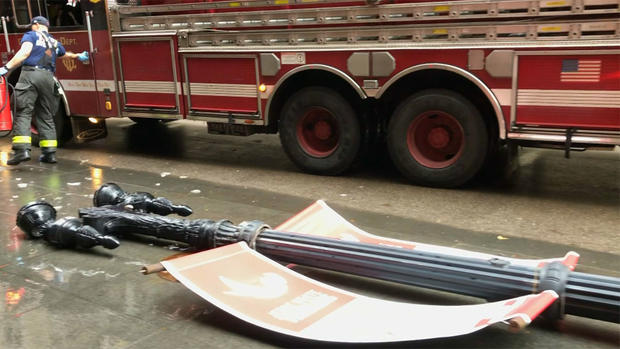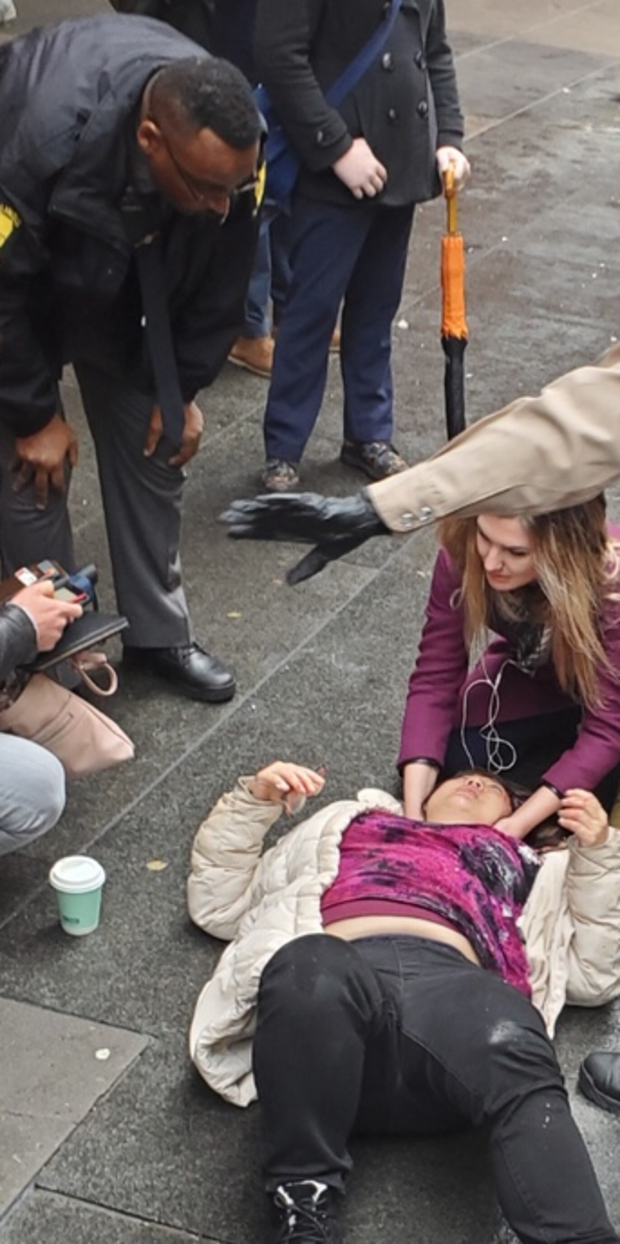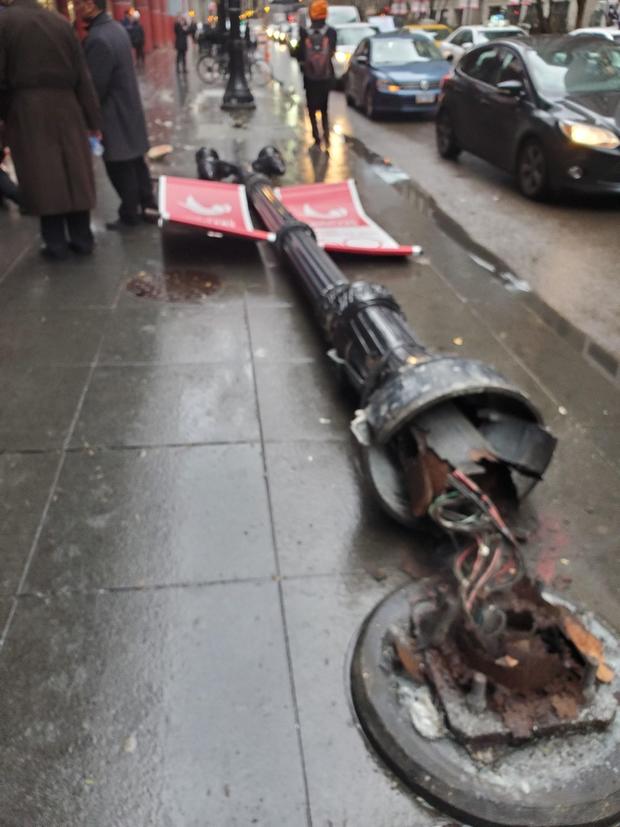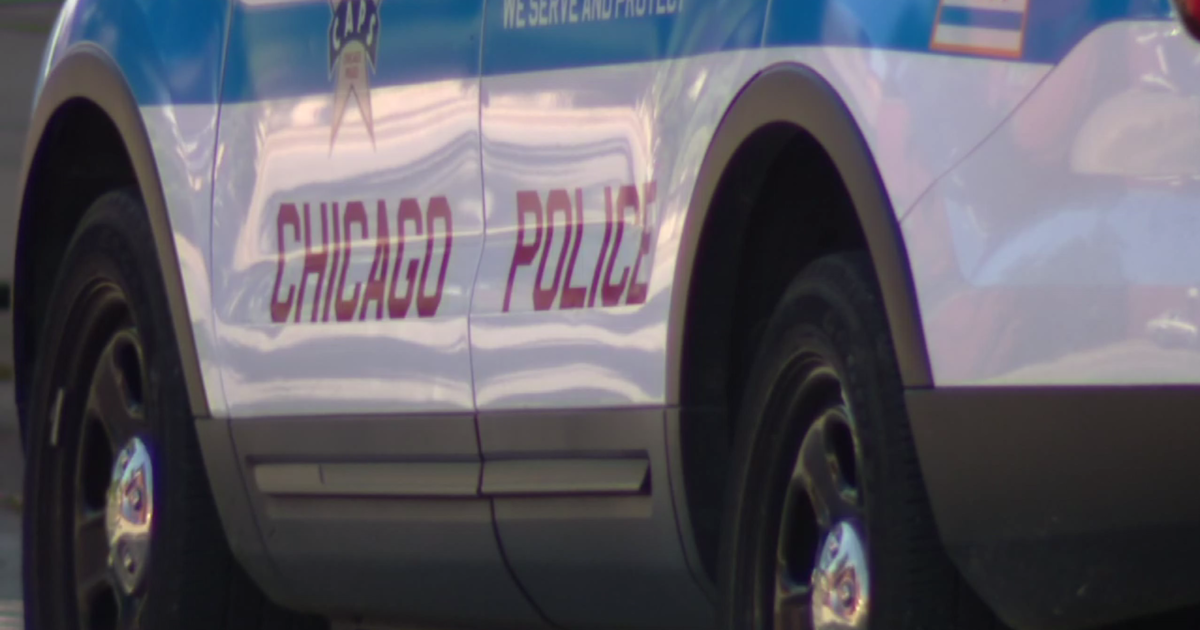Woman injured by falling light pole in downtown Chicago in 2019 to get $2 million settlement
CHICAGO (CBS) -- Taxpayers soon will be shelling out $2 million to settle a lawsuit filed by a woman who was hit by a falling light pole in the Loop that had been rusting for years.
On Monday, the City Council Finance Committee is expected to approve that $2 million settlement with Maya Kirk, who was seriously injured by a falling light pole outside the Thompson Center more than four years ago.
Her attorneys have said her case is an example of clear negligence by the city when it comes to fixing rusting light poles – an issue the CBS 2 Investigators have been reporting on since 2015.
Kirk sued the city over her injuries in 2019, and reached a settlement agreement in October 2023, according to Cook County Circuit Court records.
If approved by the Finance Committee on Monday, the full City Council could give final approval to the settlement on Wednesday.
"I had no idea what hit me"
Kirk was walking back to her office in the Loop after lunch on Nov. 21, 2019, when she was struck by an ornamental light pole that had been quietly corroding for years. Kirk suffered serious injuries to her head and leg when the pole snapped at its base as she walked past the Thompson Center, at 161 N. LaSalle St.
"I think I was in so much pain at the time…not a lot was registering at that moment," Kirk said in a previous interview. "But I was just thinking, 'That fell on me. How am I still here?'"
Unbeknownst to Kirk, the light pole had been quietly decaying — its base rusting in the elements. Without warning, it finally gave way, landing directly on her.
"I had no idea what hit me," she said in an interview in the weeks after the accident.
"These poles can kill somebody"
Dazed, Kirk struggled to make sense of what had just happened. Passersby rushed to help, but the damage had already been done.
Her femur was shattered, along with her knee. Both required surgery. She suffered a concussion and was bleeding from a cut on her head.
While recovering in the hospital, a friend showed Kirk a series of stories by CBS 2 investigating Chicago's poorly-maintained light poles — A series we first reported in 2015. It was then she realized she wasn't the only one.
Infrastructure experts have told the CBS 2 Investigators that light poles which sit on a metal box where all the wiring is housed have a design that creates the right conditions for accelerated rust. Moisture gets trapped inside from rain and snow along with road salt.
In Kirk's case, the light pole had a decorative cover that also trapped moisture from rain and snow.
"These poles can kill somebody," Kirk said, "and I just - I'm lucky to be alive."
Stil recovering from her injuries, Maya Kirk reached out to CBS 2 weeks after her injury. She was moved by the stories of the other people hurt — especially 13-year-old Noni Brown, who suffered a fractured neck when a light pole fell on her outside her school during recess in 2007.
"It broke my heart to see that," Kirk said. "For a little kid to have to go through that — and I'm sure she's got some trauma just from that experience."
Kirk said she's also angry the city didn't do something sooner.
"I knew that was something that could have been prevented," she said.
City vowed to speed up repairs
The CBS 2 Investigators have been documenting dangerous light poles since 2015, identifying frightening examples of decayed poles that fell and injured people or caused damage across the city. This includes hundreds of 311 complaints.
There have been thousands of complaints about falling light poles – hundreds of which caused property damage. There have also been other complaints of serious injuries – including multiple schoolchildren who have been struck by falling lampposts while walking to school.
The city has been sued over the issue repeatedly.
The Chicago Department of Transportation hired a subcontractor inspect poles visually about five years ago. In 2017 and 2018, the city went ahead with a survey of poles across the city and vowed to replace the dangerous ones.
In 2021, the city accelerated its effort to replace its bad or outdated poles with brand new light poles, foundations, and wiring – investing $112 million into pole replacements spanning 280 city blocks.
"That's approximately double our average of what we've doing the past few years," Tom Carney, first deputy commissioner for the Chicago Department of Transportation (CDOT), said at the time. "We're happy that we're making this infrastructure investment. It approves the livability in neighborhoods where you have new lighting. It's a long-term investment."
Months after that announcement, CBS 2 obtained and analyzed the findings of a CDOT-commissioned survey that graded every pole. We found the city department responsible for maintaining the infrastructure was warned about concerning poles, but it failed to repair or replace many of them. According to experts and residents, some of these poles were a danger to the community.
CDOT said it replaced more than 2,000 substandard light poles last year:
"In recent years, the City of Chicago has significantly increased its investments in our extensive streetlight network, which encompasses 334,000 units citywide. This includes accelerating the pace of replacing damaged poles.
In 2023, CDOT replaced more individual streetlight poles than in any previous year, marking the third consecutive year of increased replacement. Specifically, CDOT replaced 2,173 individual poles in substandard condition in addition to installing new lighting infrastructure on 215 total blocks of residential and arterial streets. Since 2021, CDOT has replaced over 5,455 poles and installed new lighting infrastructure on 527 blocks of residential streets and 254 blocks of arterial streets.
The survey completed in 2017-2018 as part of the Chicago Smart Lighting Program was a first step in the process of identifying poles that were showing signs of deterioration and prioritizing replacements. CDOT continues to use data and feedback from residents and aldermen about poles in need of replacement. Chicago residents are encouraged to use 311 to report street light poles that have been severely damaged by submitting a "Street Light Pole Damage Complaint.""
"A Scary Number"
There are more than 330,000 light poles that line Chicago's streets – all are integral to illuminating neighborhoods and keeping them safe.
To understand the condition of every pole, CDOT hired a sub-contractor to visually inspect each one in 2017 and 2018. The survey cost more than $2.5 million and was conducted as part of the city's Smart Lighting Project, according to city records.
Auditors provided each pole with a rating or grade across multiple categories, including rust, lean, general damage, and damage to the anchor bolts. Ratings range from describing poles as having no observed issues to major problems.
CBS 2 obtained the raw data of the study – the closest thing the public has to help understand the state of light poles in the city.
Of the 330,000 light poles in the city, more than 33,000 poles, or 10 percent, were graded as having some sort of serious issue across all four of the major categories, our data analysis found.
"That's a scary number," said Dr. Sammy Tin, formerly a professor at the Illinois Institute of Technology. "Aging infrastructure, deferred maintenance are tremendous issues – not just in Chicago, but across the country."
Tin, a metallurgist, now heads up the University of Arizona Materials Science and Engineering Department. He's spent years visually examining Chicago's light poles.
He said rust is often a key indicator of a deeper problem with the integrity of the pole. More than 22,000 poles were rated as having a concerning amount of rust, the data shows.
Following that survey in 2017 and 2018, CDOT said it had replaced more than 2,000 light poles through March of 2022.
CDOT did not provide specific details when asked how the department formally prioritizes fixes, replacements and in-depth inspections for poles.






